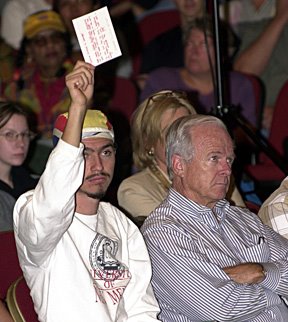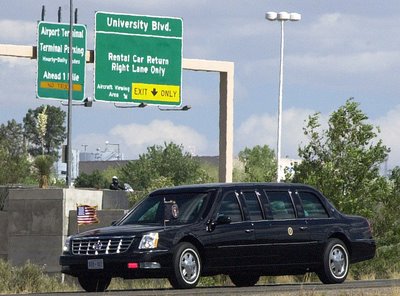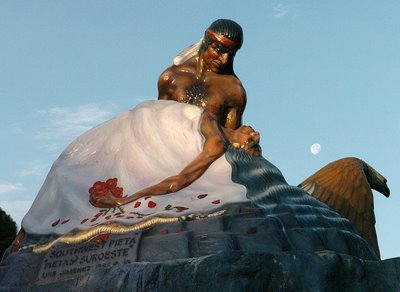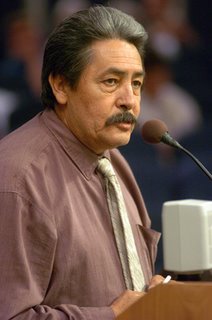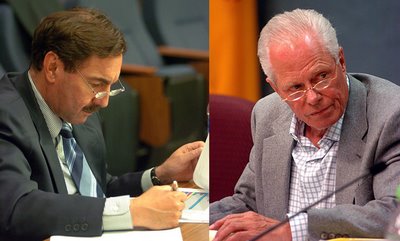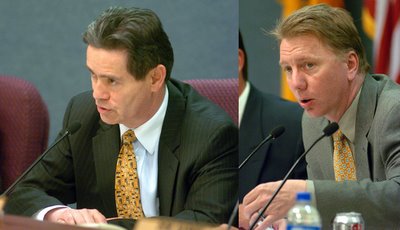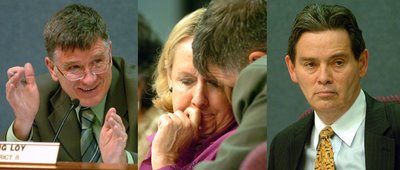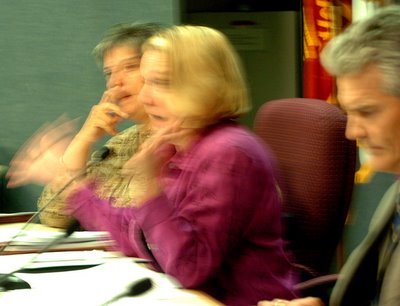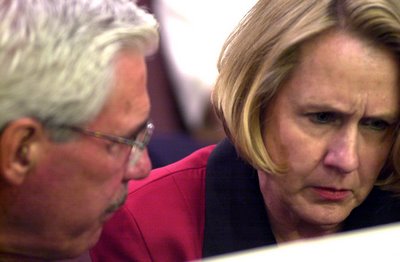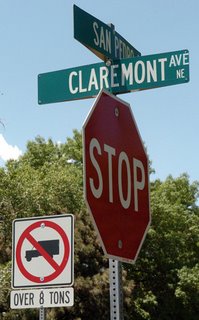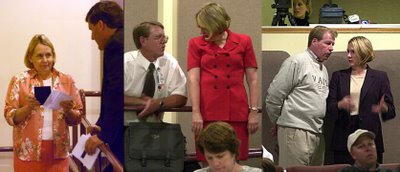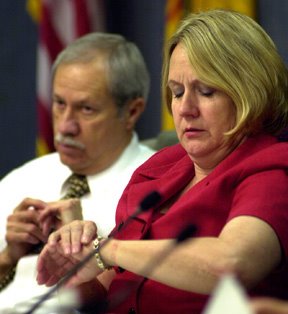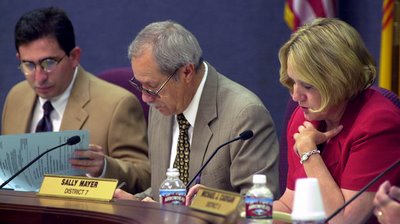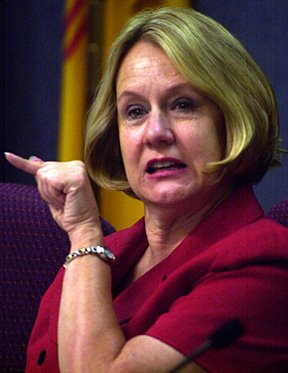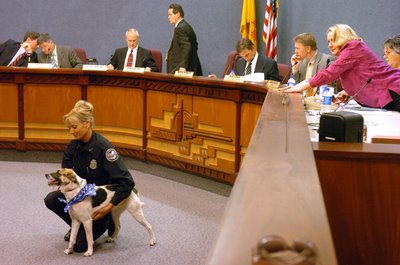What's wrong with this picture?
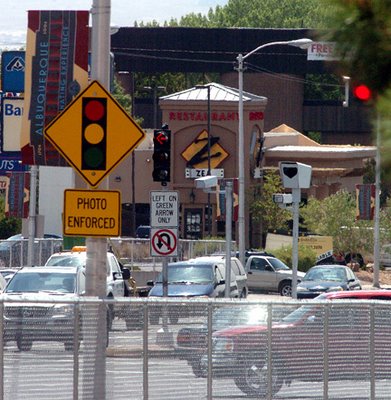
This is a photo red light camera at Montgomery and San Mateo Boulevards.
It was the first of five intersections where red light cameras have been installed. The other locations are Montgomery and Eubank Boulevards, Eubank and Lomas Boulevards, Paseo Del Norte and Coors Boulevards, and at Montgomery and Wyoming Boulevards.
A single van with a photo radar camera recorded more than 2,000 speeding violations in school zones in a four-month period prior to school recessing for the summer. The city is now obtaining two more and expanded their use from just school zones to anywhere in the city.
Mayor Martin Chávez claims in a Journal article that the use of red light cameras is all about public safety.
So what's wrong with this picture?
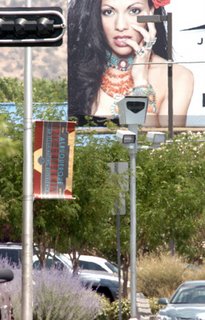
Big Sister, Big Brother. This bejeweled woman on a billboard for a local jewelry manufacturer appears apprehensive as she looks over the city’s pole-mounted photo red light camera array at the intersection of Montgomery and Wyoming.
“We the People” is the basis of our form of government. It is not just the rules that we follow but a philosophy we maintain.
Where are the people; the people of the government?
The United States Constitution divides our form of government into three branches: legislative, executive and judicial. The State of New Mexico has its own Constitution that mirrors the federal Constitution. The state also has provided for municipal home rule. It allows Albuquerque to form a government, within certain limitations, by adopting a charter. The charter and city ordinances may not exceed either the federal or state constitutional limits.
One of the limitations on the city is that they may not have their own judiciary. Up until 1979, the city of Albuquerque had a municipal court system, but the state abolished it.
Courts generate revenue from fines and fees for convictions of violations of statutory law, ordinances and traffic offenses.

When Albuquerque had its own courts, it was able to control the revenues generated for violations of their ordinances and traffic offenses. New legislation took effect July 1, 1980 with the opening of the Bernalillo County Metropolitan Court. The City of Albuquerque’s Municipal Court, Bernalillo County Magistrates’ Court and Bernalillo County Small Claims Court were consolidated. Under the state judiciary, all fines, fees and other revenues went to the state treasury before a portion was returned to the city. This system represented a major loss of revenue to the city.
In part, in an effort to regain control over the loss of revenues to the state, Mayor Martin Chávez and his legal department convinced the city council to expand their notion of using criminal nuisance abatement laws as a way to circumvent the state’s courts and make money.
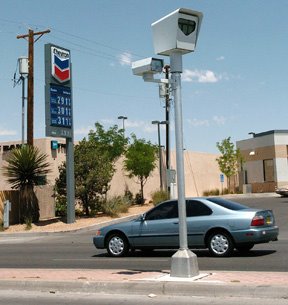
The Safe Traffic Operations Program or STOP ordinance established the use of unmanned electro-mechanical photo red light and photo radar camera devices as the evidentiary gathering and charging instruments.
STOP declares that a vehicle is a criminal public nuisance for which the registered owner is responsible.
The city went on to create an administrative hearing officer process to adjudicate challenges to the notices sent to the registered owners of vehicles based on the license plate depicted in a digital image photographed by the cameras.
The photo red light and photo radar units are owned and maintained by a private vendor. A police officer reviews the video and photographic images to assure there is an apparent violation of state statute or city traffic code. However, it is the vendor who handles the notification and collection of all fines and fees.
Several issues instantly arise.
Though the state permits the city to establish what a public nuisance is and may set a penalty as a petty misdemeanor punishment – a maximum $500 fine or 90-days in jail – the city may not establish its own adjudication process.
The city exceeds the maximum penalty when it allows for the seizure and forfeiture of the vehicle if the registered owner fails to respond to the city’s notice.
The Constitution of the State of New Mexico in Article X, County and Municipal corporations, Section 6 on Municipal home rule, Subsection D, states, “A municipality which adopts a charter may exercise all legislative powers and perform all functions not expressly denied by general law or charter. This grant of powers shall not include the power to enact private or civil laws governing civil relationships except as incident to the exercise of an independent municipal power, nor shall it include the power to provide for a penalty greater than the penalty provided for a petty misdemeanor….”
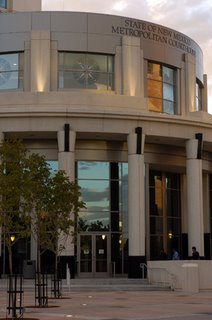
Several sections of the state statutes make it absolutely clear that in Bernalillo County, the adjudication of all criminal, civil and traffic offenses under state statute and municipal codes are handled by Metropolitan court which shall have jurisdiction within the county boundaries over all: offenses, complaints and violations of city ordinances. Further, state statutes establish original exclusive jurisdiction over all Motor Vehicle Code or municipal traffic code violations.
There are two exceptions: the Metropolitan court shall not have jurisdiction over uncontested municipal parking violations, meaning, the city may keep all those fines, and “A civil action to abate a public nuisance may be brought, …in the district court of the county …where the public nuisance exists.”
The STOP ordinance, in theory, most closely parallels the city’s parking violations code. The state legislature granted a specific exception for gathering of uncontested municipal parking violation fines. Parking tickets are issued by agents of the parking enforcement division or by police officers upon their observations of offenses; yet, the jurisdiction for contested violations is still Metropolitan court.
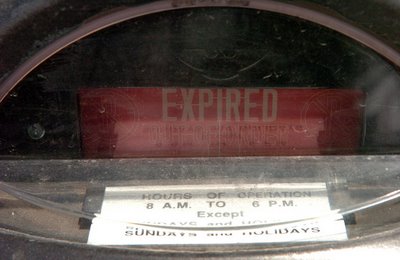
The STOP ordinance was not the first or only law the city established for criminal nuisance abatement. It started with attempting to control deteriorating motels and has expanded to the seizing and forfeiture of vehicles operated by people arrested for driving while under the influence of alcohol or drugs if they have a prior DWI conviction.
Nor will the STOP ordinance be the last. There is currently a proposed ordinance that will decriminalize some 72-city ordinances, making them subject to the city’s theory that they can adjudicate criminal nuisance abatement.
The ordinance is being carried by request of the administration through City Councillor Sally Mayer. Mayer, in an e-mail to her political supporters, countering the recall petition, writes about the penalties of her animal control “HEART” ordinance, “…In fact all violations of city ordinances are petty misdemeanors except for our red light camera violations which are civil.” Her statement belies her lack of understanding of her legislative authority and the criminal justice system’s procedural requirements.
This lack of understanding is not all her fault. Her fellow Councillors, Michael Cadigan and Don Harris are attorneys and former Albuquerque Police Captain Craig Loy fail to understand their basic civics lessons. They, if anyone, should know better.

Councillors Mayer, Harris, Cadigan and Loy
At a recent council meeting, I challenged an amendment of increasing fines they were deliberating, to the existing STOP ordinance’s “civil” designation and its lack of jurisdiction. Harris, who was an assistant city attorney, said he too was concerned about the city’s jurisdiction. Assistant City Attorney Greg Wheeler assuaged council’s concerns by misstating the fundamental concepts of our democratic form of representative government.
The executive, here in the form of the mayor, appoints all the actors. The enforcement personnel, the administrative hearing officer, the assistant city attorney, the city clerk and the contracted vendor all now work within the executive branch.
This effectively eviscerates the judiciary. The separation of powers is obliterated by the theory.
The Constitutions, federal and state and the city’s own charter, recognize an independent judiciary. An accused is guaranteed a; presumption of innocence, right to reasonably obtain evidence, right to a fair trial, right to confront an accuser, to cross examine, and to bring in witnesses on their behalf, the right to have a minimum burden of proof, that each and every element of a statutory violation is proven “beyond a reasonable doubt” and the right to appeal to a higher court.
The city’s nuisance abatement ordinances eliminate several of those rights by convoluting their ordinances to allow for what they call a civil process. They do not have the authority to create a civil process. Even if they did, the adjudication of the issues still belongs exclusively to the judiciary.
The city argues that they can have administrative hearing officers. I agree. Except the hearing officer is limited to determine facts related only to the administration of city issued permits, like public health standards for restaurants, issuing of building permits, enforcement of building codes, zoning and licensing businesses as required under their various ordinances. Even then, the hearing officer’s ruling may be appealed, ultimately to District court.
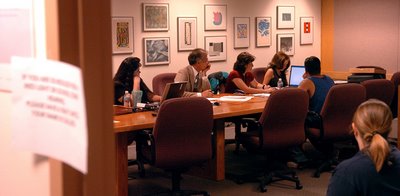
The hearing officer does not represent an independent jurist, but the executive. Hearings take place in the executive’s building, again not the neutral setting of an independent judiciary.
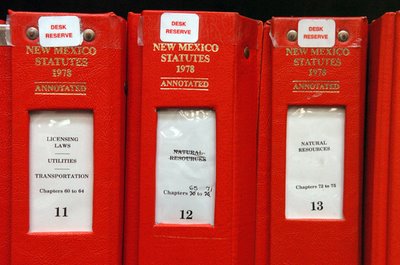
“We the People” also means that enforcement of our social requirements that we call laws, statutes, ordinances and codes are a human interaction, not just a technological exercise. Though there are and always have been some inherent problems associated with people administering justice, it is a civil human process that assures that justice is served.
Is the goal for the city to eliminate any and all procedural, legal or budgetary impediments between alleged offenses and the inside of their citizens’ wallets?
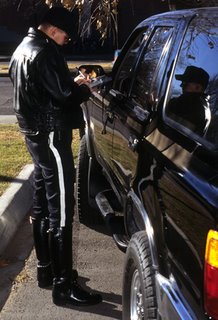
It is the people, in “We the People,” who will make the process work, not some machine that treats a person simply as computer data and minutiae without the human qualities of heart or head, experience, wisdom or understanding. Guilt is reduced to just yes or no, a mechanical lightning-strike determination, made at a diminished level of proof, with none of the legal protections guaranteed by our great documents.
It has always been my understanding that the purpose of law was to hold individuals responsible for their specific acts of a criminal nature. So, how does a vehicle that is totally legal one second, become a criminal public nuisance in another and then is totally legal again?
Someone is going to have to explain to me very convincingly, how the progression and adoption of the Anglo-Saxon common law to the American justice system over the past 900 years is all of a sudden changed to a game of “Gotchya!”

Both the state’s motor vehicle statutes and city’s traffic codes require all traffic offenses be made by arrest by an officer, upon personal observation, in a marked police unit, while in uniform displaying the badge of office. The exception is, when there is an accident, the officer need not witness the event. The state legislature, in its wisdom, decided that officers should stop motorists as soon as they observe a traffic violation. There are excellent reasons for doing this including; when it comes to court, the identity of the driver is already established.
The arrest is terminated when the driver signs the citation promising to answer the charge. It begins the process of separation of powers, because the next step for the citizen is with the courts.
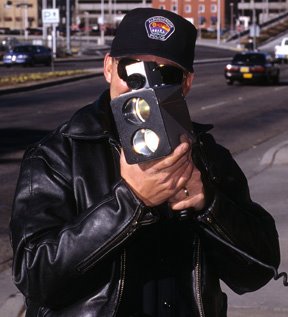
The use of radar by officers was not meant to be used as a fish net, but more like a fly cast, directed at a specific target. Court cases ruled that officers needed to visually identify a vehicle as speeding before using radar to confirm how fast it was going.
Government is to leave its people alone. It’s called freedom; you know, like in, “…the land of the free and the home of the brave,” and “…Liberty and Justice for all!”
It’s encapsulated in that pesky fourth amendment. An officer must be able to articulate facts in developing probable cause, or the lesser test of reasonable suspicion, before government is allowed to look closer at its citizens’ behaviors and to conduct a reasonable, yet warrant less search or seizure, a stop. Using the always-on passive radar or the unblinking eye of cameras constitutes a governmental intrusion of the populace. It is guilt until proven innocent, not the required presumption of innocence until proven guilty.
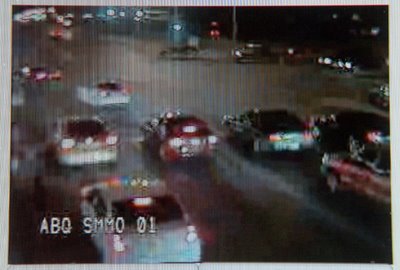
This is technology for technology's sake.
There is this one other little problem before the mayor and his henchmen and minions can try to exercise their grand scheme. We must start at the beginning. The notices of violations are predicated on violations of traffic control devices: red lights and speed zone signs. They are legal instruments allowed only through a legal process. The process is the state motor vehicle code. The mayor may, after conducting a traffic safety study, authorize the placement of traffic control devices. The only allowable way to enforce those legal instruments is through the same motor vehicle code that allowed for their placement. To do anything else brings into question the initial reasoning for their existence.
What is this noise, Mayor?
“…He has obstructed the administration of justice, by refusing his assent to laws for establishing judiciary powers.
He has made judges dependent on his will alone, for the tenure of their offices, and the amount and payment of their salaries.
He has erected a multitude of new offices, and sent hither swarms of officers to harass our people...
...He has combined with others to subject us to a jurisdiction foreign to our constitution, and unacknowledged by our laws; giving his Assent to their Acts of pretended Legislation:
…For imposing taxes on us without our consent:
For depriving us in many cases, of the benefits of trial by jury:
… For taking away our charters, abolishing our most valuable laws, and altering fundamentally the forms of our governments:
…In every stage of these oppressions we have petitioned for redress in the most humble terms: Our repeated petitions have been answered only by repeated injury. A prince, whose character is thus marked by every act which may define a tyrant, is unfit to be the ruler of a free people…”
Where have we heard this before? In a couple of weeks we will celebrate these words. It is hoped that Mayor Chávez, Chief Administrative Officer Bruce Perlman, City Attorney Bob White, Assistant City Attorneys Wheeler, Pete Dinelli and Dennica Padilla, Chief Public Safety Officer Nick Bakas, Chief of Police Ray Schultz, Lt. Robert Haarhues, APD’s STOP coordinator and City Administrative Hearing Officer Albert Chavez consider the similarities of the offenses they engage in today in light of Thomas Jefferson’s words of the Declaration of Independence some 230 years ago.

Chávez, Perlman, White, Wheeler and Dinelli

Bakas, Schultz, Haarhues and Chavez
Before you listen to the beautiful sounds of Linda Ronstadt at the city’s Fourth of July concert, go back and read the beautiful words of revolution!
Here, have a firecracker, puff on it, while I light it for you.
 Sheriff Darren White ordered a new paint scheme for the Bernalillo County Sheriff’s Department’s marked units.
Sheriff Darren White ordered a new paint scheme for the Bernalillo County Sheriff’s Department’s marked units. No, I’m not a deputy, only a resident. I am not an art critic, having dropped out of an art history class when I had a personal crisis.
No, I’m not a deputy, only a resident. I am not an art critic, having dropped out of an art history class when I had a personal crisis.

















